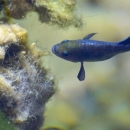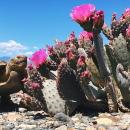Visit Us
Moapa Valley National Wildlife Refuge (NWR) is open to the public from 8:00 am- 4:00pm every Friday, Saturday, and Sunday from September through May. Due to the refuge's small size, fragile habitat, and ongoing restoration work, the refuge is closed during June, July, and August. Please note: The refuge is temporarily closed to the public through November 2024.
Activities
Moapa Valley National Wildlife Refuge is only 136 acres in size, and offers activities that can be enjoyed within a leisurely day.
- Take a streamside stroll through the oasis while looking for dragonflies and hummingbirds
- Visit the stream viewing window to glimpse into the underwater world of the endangered Moapa dace, Moapa White River springfish, and other aquatic wildlife in their native environment
- Learn more about the refuge, local wildlife, and the Moapa Valley from the informative displays throughout the refuge
- Pack a lunch to enjoy in the pavilion, which offers shade and picnic tables.
- Go for a walk on the Overlook Trail. After you climb the trail, you can read the informational placard and enjoy the breathtaking view of the green valley oasis, including the refuge, the neighboring Warm Springs Natural Area, and the surrounding mountains. This trail is a half-mile loop and is moderately challenging.
Other Facilities in the Complex
Moapa Valley National Wildlife Refuge (NWR) is managed as part of the Desert National Wildlife Refuge Complex. A National Wildlife Refuge Complex is an administrative grouping of two or more refuges, wildlife management areas or other refuge conservation areas that are primarily managed from a central office location. Refuges are grouped into a complex structure structure
Something temporarily or permanently constructed, built, or placed; and constructed of natural or manufactured parts including, but not limited to, a building, shed, cabin, porch, bridge, walkway, stair steps, sign, landing, platform, dock, rack, fence, telecommunication device, antennae, fish cleaning table, satellite dish/mount, or well head.
Learn more about structure because they occur in a similar ecological region, such as a watershed or specific habitat type, and have a related purpose and management needs. Typically, a project leader or complex manager oversees the general management of all refuges within the complex and refuge managers are responsible for operations at specific refuges. Supporting staff, composed of administrative, law enforcement, refuge manager, biological, fire, visitor services, and maintenance professionals, are centrally located and support all refuges within the complex.
Other refuges in the Desert National Wildlife Refuge Complex include: Ash Meadows NWR, Desert NWR, and Pahranagat NWR. The Refuge Complex headquarters is located at 4701 North Torrey Pines Drive, Las Vegas, Nevada 89130.
Rules and Policies
There are many interesting and educational things to see on the refuge. Please check with the staff before participating in an activity that could harm you, other people, wildlife, or habitats. The Service wants all visitors to enjoy the refuge while helping to protect it by following these rules and regulations:
- All motorized vehicles must be parked in the parking lot.
- No bicycles are allowed on the trails or pathways.
- Drones are prohibited on the refuge. Launching, landing or disturbing of wildlife by aircraft (drones) is prohibited. 50 CFR 27.34/27.61
- Stay on marked trails and pathways.
- Dispose of trash in receptacles located throughout the refuge.
- Do not abandon any animals or fish anywhere on the refuge.
- Dogs must be leashed at all times and must be kept on marked trails and pathways. Dog owners must clean up after their pets.
- Horseback riding, fishing, camping, swimming, fireworks, open fires, discharging a firearm, and off-road vehicles are prohibited.
- Collecting plants, animals, geologic materials or artifacts is against the law.
Law Enforcement
U.S. Fish and Wildlife Service law enforcement officers have federal jurisdiction to enforce federal conservation laws throughout the United States. Officers deal with a wide variety of crimes such as natural resource violations, traffic violations, crimes against people, crimes against property, homeland security and more. They protect fish, wildlife, plants, and other natural, cultural, and historical resources.
Service law enforcement officers work collaboratively with law enforcement officers from other federal land management agencies to protect Southern Nevada public lands for everyone to enjoy.
By fostering understanding and instilling in the visiting public an appreciation of refuge resources, laws, and regulations, law enforcement officers encourage voluntary compliance through education, outreach, and law enforcement actions while ensuring a welcoming and safe environment.
Locations



















The unique geology of the Moapa Valley National Wildlife Refuge makes it an important location for native wildlife. There are five major thermal springs in Moapa valley, three of which are located within refuge boundaries. The warm springs habitat supports many unique species. Moapa Dace, White River Springfish, Moapa Pebblesnail, and Moapa Riffle Beetles are all endemic to Moapa Valley, which means they are found here and nowhere else in the world.
The Moapa Valley NWR is located in the Warm Springs area of the upper Moapa Valley in northeastern Clark County in southern Nevada. It lies just south of State Highway 168 and the Muddy River, between Interstate 15 on the east and U.S. Highway 93 on the west. The refuge is bounded on the North by Warm Springs Road, on the south by Battleship Wash, and on the east and west by private property. It is approximately 60 miles northeast of the city of Las Vegas and 9 miles west of the town of Glendale.
From Las Vegas, drive north on Interstate 15 to the Moapa/Glendale exit (#90). Go straight (northwest) on Highway 168 for 7.4 miles to Warm Springs Road. Turn left (southwest) on Warm Springs Road and drive for 1.4 more miles. The refuge is on your left, when you see the chain link fence on both sides of the road.
From St. George, Utah or Mesquite, Nevada, drive south on Interstate 15 to the Glendale/Moapa exit (#91). Turn left (southwest) onto E. Glendale Blvd. Merge/turn right (northwest) onto Highway 168 for 7.4 miles to Warm Springs Road. Turn left (southwest) on Warm Springs Road and drive for 1.4 more miles. The refuge is on your left.
Moapa Valley National Wildlife Refuge (NWR) is open to the public from sunrise until sunset every Friday, Saturday, and Sunday from September through May. Due to the refuge's small size, fragile habitat, and ongoing restoration work, the refuge is closed during June, July, and August.





